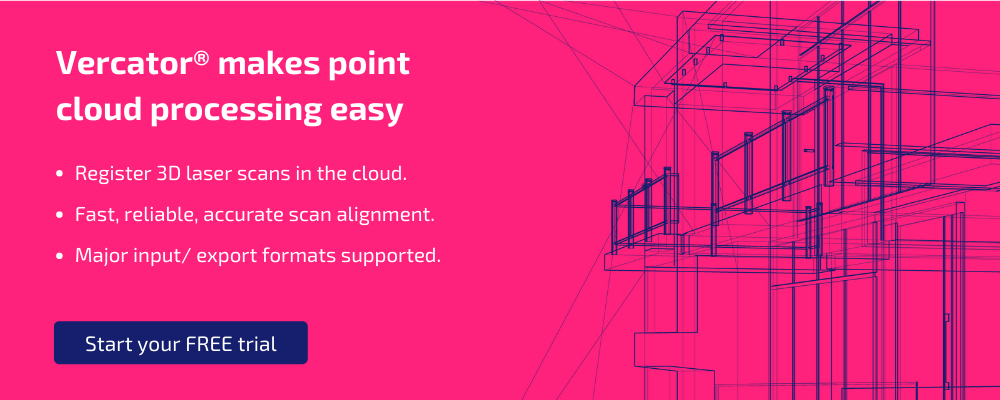4 disruptive trends in land surveying and what surveyors should be doing today

The last few years have seen significant digitisation of surveying equipment, workflows and outputs. These trends will only continue, and are coalescing to create some significant transformation in what the future of the surveying profession is likely to become.
The four trends discussed here are by no means the only changes occurring. However, we believe they are each catalysts for change. Although they are disruptive, they are also positive. With the right forethought, surveyors will be empowered to:
- Expand their services
- Improve quality
- Exceed client demands
- Reduce costs
Here, we are going to look at how surveyors can ensure that the change around them is harnessed as a positive force. Let’s get started.
Trend 1: UAVs and drones
The use of remote-control drones and unmanned aerial vehicles (UAVs) is becoming more common among the surveying and mapping professions. The technology has multiple potential applications within numerous surveying-related sectors, which range from geospatial surveying and mapping to scanning, building surveys, environmental monitoring and agriculture.
Surveyors can now get their data quickly and accurately with modern drones. UAVs also make the job safer, so human operators don’t need to enter hazardous environments to take measurements.
Some advantages to consider:
- Cover large surface areas in a short amount of time
- Cross difficult terrain
- Make inaccessible areas accessible.
- Combine land surveys, photogrammetry, 3D mapping, topographic surveying and more
Even though the technology is becoming more adaptable and user friendly, the underlying legal framework for operation is still something to be considered if surveyors are to avoid breaking the law.
But this isn’t holding back adoption. According to the CAA’s online list of approved commercial operators of Small Unmanned Aircraft (less than 20kg), there were 359 permitted SUA operators in the UK by the middle of 2014. By September 2015 that number had jumped to 1,036; and by February 2019 there were approximately 5,000 permitted drone operators in UK airspace.
What surveyors need to do:
Know and follow the rules
UAVs are easy to access but more challenging to use.
These challenges range from:
- Keeping up with the relevant operating regulations
- Getting appropriate levels of training (piloting) and assessments
- Providing professional outputs to clients
Choose a pilot project
Find a project that will:
- Build skills
- Create a workable ongoing process
- Give measurable and practical results
- Present a case for expansion
Look to do things differently rather than the same thing
- Try to avoid automating what you already do
- Look for novel ways to use the technology
Trend 2: The cloud — data access and point cloud registration
Surveying is behind the curve when it comes to the cloud. Large file sizes and complex data operations have made it challenging to deploy cloud technology. However, with the rollout of 5G and general improvements to cloud infrastructure, the limitations holding back the application of cloud services are falling away.
The shift over the next few years will be the realisation that the very features of survey data that limited cloud use have actually become reasons to apply modern cloud technology. As long as you don’t overload the access capabilities of the cloud, cloud technology is the perfect tool for managing large and complex datasets.
Specifically, when it comes to point cloud processing, the cloud presents dramatic possibilities to accelerate registration and reduce costs. This is one area we (Vercator) know a lot about — pioneering AI-enabled registration software that removes manual oversight and allows surveyors to take full advantage of scalable parallelisation of processing using cloud computing to overcome large datasets.
When partnered with 5G, efficiency is further increased. The barrier between the office and the field is eroded, data can be shared as soon as it’s captured, and in-field registration undertaken immediately. Site visits are reduced and remote collaboration made easier — something particularly valuable in the era of “social distancing”. All of this is in addition to an increased ability to share and integrate data across a wide range of deliverables.
If you want to learn more about these capabilities, you should:
- Check out our free ebook Are you ready for the cloud?
- Download a free trial of Vercator to see how cloud registration might integrate into your workflow.
What surveyors need to do:
Investigate cloud-enabled software
More companies are offering cloud-based solutions that take advantage of the processing power and scalability available in the cloud, without surveyors having to know the intricacies of cloud services.
Become BIM experts
With the advent of BIM (Building Information Modelling), the need to have one source of truth for projects, sharing data and monitoring results is firmly pointing towards a cloud solution. And the first place to start is with scanning. Cloud adoption makes integration within construction projects far simpler and more effective for both surveyors and project managers.
Understand the data
A lack of standardisation in organising data can make it difficult to turn it into something meaningful. This is particularly the case when different project clients have different requirements of what data they want and how it should be presented to meet their specific needs.
Understand what data to input to generate a subsequent data output. You need to be able to advise clients on the correct data requirements so systems can work effectively and support system-based collaborative working.
Trend 3: Mobile mapping
The dream would be to go out into the field, set up an instrument and just let it do all the measurements on its own.
Mobile mapping systems almost fulfil that promise. Systems fit in a backpack or are a compact mobile device. They scan indoor environments with either cameras or laser scanners. Data sets are georeferenced and point clouds can be coloured by using cameras as well as laser scanners.
The key advantage of these 3D mobile mapping systems is the speed at which they can acquire scan data . They are flexible and allow you to create 3D models from a wide variety of environments. Indoor, outdoor and underground areas can all be captured with this mapping technology.
For example, a land surveying firm conducted a scan of a nursing home using a handheld scanner using Simultaneous Localisation and Mapping (SLAM) technology. The team reported that the scanning exercise took just 30 minutes, when it would normally take closer to three days using static equipment.
Scanning while walking can often deliver 5 to 10 times more field productivity over tripod-based scanners. Although this process is not nearly as accurate as standard LiDAR, it’s a technology that will play an increasingly important role in future applications and is likely to only improve in accuracy and quality over time.
What surveyors need to do:
Build expertise and knowledge
Versatile equipment options and handheld devices make mobile 3D mapping a viable approach for many land surveyors. Try them out and build up experience of when and how to use them.
For example, Bentley provides a mobile phone capture and cloud processing app. Based on a series of around 50-100 photos of a location of interest, it can automatically create a 3D reality model. Again, this technology is not accurate enough to replace standard survey equipment, but it is an interesting development.
Look how to incorporate mobile capture with other methods
The critical step for applying mobile 3D reality capture technology is thinking about creative ways for its application. Increased options for scanning makes it more important to think about the LoD (level of detail) required for specific jobs and using the best tool for that outcome.
You might consider using different tools simultaneously. One of the most notable benefits of 3D mobile mapping is real-time, instant results. You can transform your data into 3D visuals quickly, reducing the time it takes to see results. Associated 3D-mapping software also tends to offer robust organisational features, such as bundling data into projects and managing single uploads automatically.
Trend 4: Increased accessibility and integration
Fundamentally, surveyors have more opportunities to work more closely in a wider variety of environments. To execute on this, surveyors need flexibility, a desire to embrace technology and the ability to think more creatively about where skills can be deployed.
It’s a challenge that surveyors seem to be up for.
According to a recent RICS survey on the impact of technology on Surveying,
- The use of technology by surveyors has increased from 60% to 68% in two years,
- Those with a digital strategy in place (or those working on one) has risen from 57% to 79%
- 95% of respondents said that technology presents an opportunity.
The key initiatives needed to drive transformative change in another recent RICS survey were found to be:
- standardising technology across the supply chain
- uplifting the skills pool
- improving supply chain collaboration
- ensuring senior teams are committed to driving innovation
Three out of four of these transformative initiatives have something in common: they are about people rather than processes. Managing and developing teams is often one of the biggest challenges preventing the successful adoption of new technology. It’s also where all of the benefits are seen. If you adopt new technology but don’t change how you work, very little will be gained from that investment.
What surveyors need to do
Learn new skills
The surveying profession is knowledge intensive. Through lifelong learning, surveyors will be better able to take advantage of the latest technology, and that will drive productivity and innovation.
The value-add of a surveyor is the knowledge that they possess. The surveyor of the future will need to be:
- More strategic in approach
- Embrace lifelong knowledge acquisition and knowledge management
- Be able to transfer knowledge between and across projects
- Be tech-savvy
As data-driven decision making becomes embedded, surveyors will also need to better understand how to draw valid inferences from data. To achieve this, data analysis skills and specialisms will enter the profession.
Look for real outcomes
The first step in making sure you achieve a positive outcome is to identify the maturity of the technology. The use of BIM, for example, has been well reported over recent years. But it’s only recently that the technology needed to deliver the real benefits of BIM to access data integrations and visualisations has become a reality.
According to Adam Jacob, the former CTO of Chef, an IT software company:
“The tools we use reinforce the behaviour; the behaviour reinforces the tool. If you want to change your behaviour, change your tools”.
In other words, don’t look to technology for technology’s sake. Look for it to aid and abet your digital transformation.
One way to test where you have to “disrupt yourself” is in the answer to the following four questions.
- What’s working well?
- What could be improved?
- How would technology benefit my team practically on an individual and a group level?
- Who can help me embed trust to allow for a culture that embraces digital?
In these disruptive times, any profession that has at its core data collection overlaid with acquired skills is at risk. Any profession that is primarily to do with interpersonal relationships is unlikely to be so affected.
There will always be demand for building surveyors who have specialist knowledge, experience and the ability to well present the advice they give. The job of surveyors today is to make sure that they can master the tools they will be required to use tomorrow.


